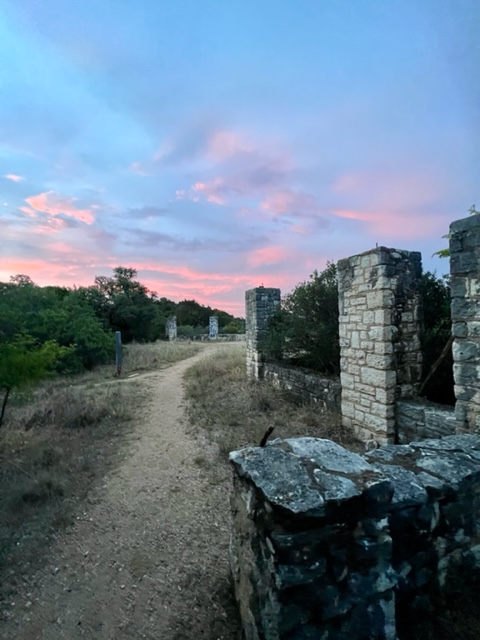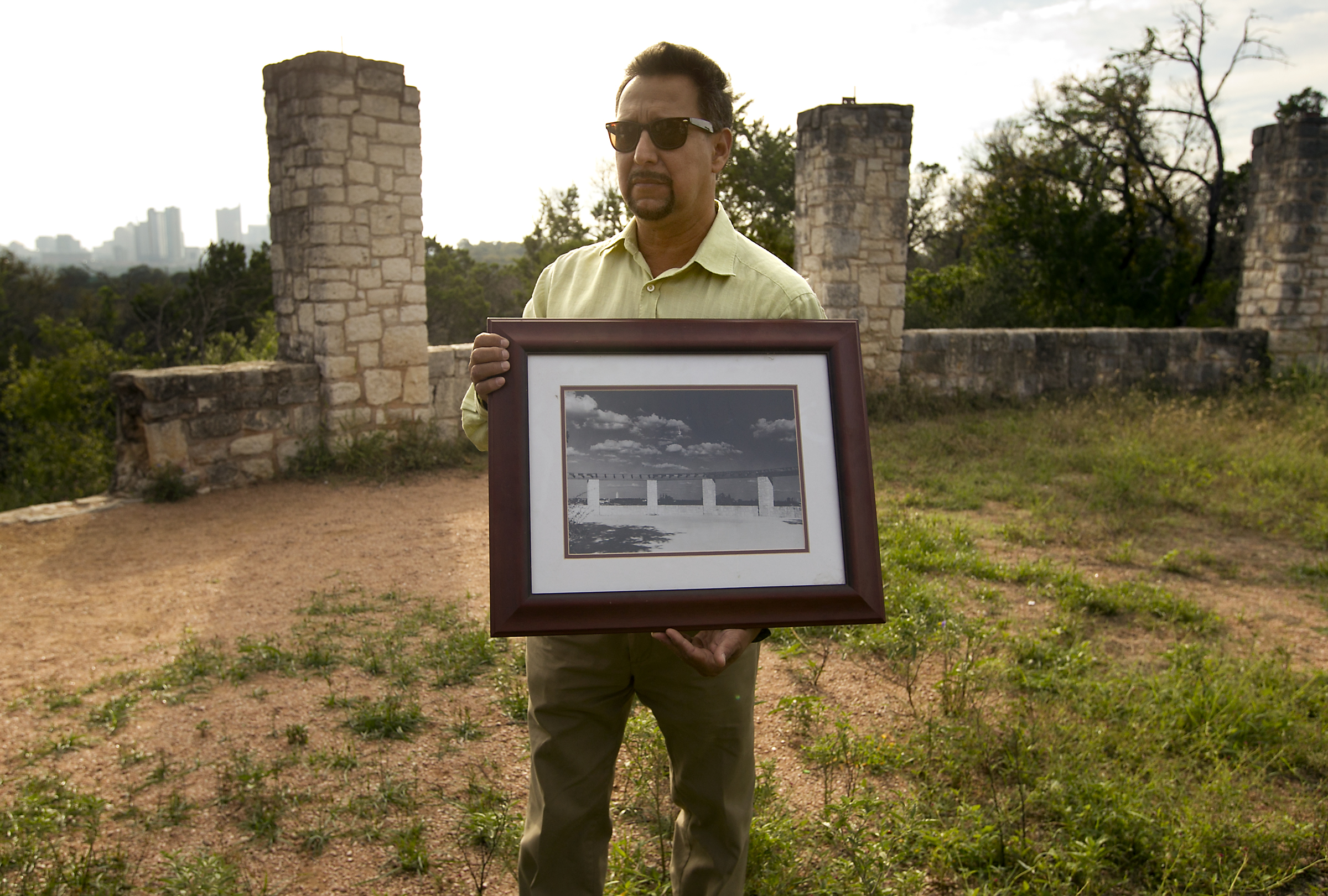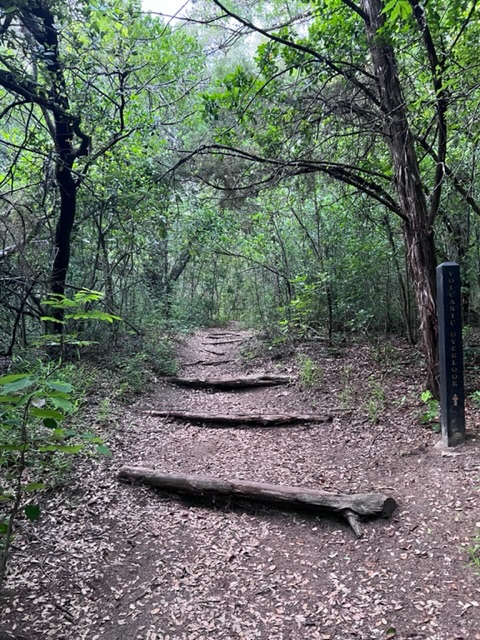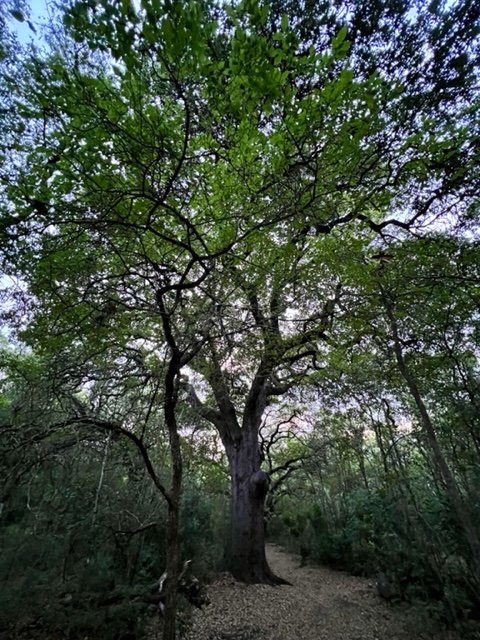
The author pauses for reflection before a mural under Mopac. Photo by Vanessa Hartman.
I didn’t even know it was there until I made a trip with my son to the Austin Nature & Science Center, a natural history museum for kids near Lady Bird Lake. The grounds feature a waterfall, trail, and dinosaur pit with play bones for children to dig up. After my son finished shoveling buckets of sand to uncover these treasures, I took him inside and we inspected other artifacts: sparkly rocks, fossils, animal fur, taxidermy snakes, and butterfly collections. We were about to leave for lunch when I stopped by the water fountain for a drink and noticed something out back. Behind a bird exhibit, I saw a fence and a gate. And behind that gate, I saw a trail leading down a hill under a canopy of trees. I couldn’t resist. I grabbed my kid and walked toward what turned out to be the little-known back way into the Zilker Nature Preserve, the prettiest and most secret woods in Austin I’ve ever seen.
I’ll never forget that day 10 years ago. It was my first spontaneous hike. A hidden world opened to me, and I discovered a hidden person—a writer—inside of me.
Because I was a single father at the time and my son was only 4 years old, I couldn’t venture out for a proper hike. So, I stuck to skirting the woods near playgrounds so he could stay occupied. But as my son got older, we’d return to Zilker Preserve when we could and climb the tallest hill, zigzagging on switchbacks of limestone rock over a trail covered with copper leaves, up to the top, to a beautiful overlook called Lookout Point. Like some unfinished fortress missing the cannons, a row of limestone pylons spray-painted with graffiti stands at the peak. The lovely view ahead is all Austin skyline surrounded by busy roadways and treetops.

The path to Lookout Point in the Zilker Nature Preserve leads to a panoramic view of Austin. Photo by Bobby Alemán.
The place is incredibly hidden. Zilker Preserve is the speak-easy of Austin parkland. There are only three entrances (well, four if you count the back way in). One is basically in an alley that dead ends. Another is right by an underpass. And the other is completely hidden in the summer with tree branches—you have to know exactly where the entrance is, and you must duck under foliage like you’re sneaking backstage. A wooden staircase then leads you into a wooded area so lush and so alive were a brontosaur to step out from the tree line, chewing on leaves, you wouldn’t be surprised.
Fast forward to 2020 and the surreal life of the pandemic. My son was now a teenager, in virtual school, staring at his laptop. And businesses were shut down, including my own. I now had plenty of time to hike in the woods. I put in hundreds of miles that year, hiking Austin in a constant state of wonder. I crossed every park and greenbelt I knew of off my list, and I started writing stories about my adventures. There was one place, though, I kept putting off like some errand: Blunn Creek Nature Preserve. How could a little parcel of land by Interstate 35 show me anything I hadn’t already seen?
In February, I opened a tweet by Michael Barnes, a journalist with the Austin American-Statesman, containing a link to an article he wrote about historic sites in the Zilker Park area. When I opened it, I saw a photo of a man holding a framed picture in his hands, posing on top of Lookout Point, the same scenic overlook my son and I had climbed at Zilker Preserve. He was holding a picture of the exact place where he was standing. I know where that is! The man could have gone for a cool jazz daddy-o, with his slick black hair and Ray-Bans, pencil mustache, and silk green shirt. He oozed Chicano cool in a picture accented with sepia color tones and album cover vibes. His name was René Barrera, and he managed all of Austin’s nature preserves.

René Barrera was a valued steward of Austin parkland. Photo courtesy Austin American-Statesman.
Preserves are a special kind of parkland. They are “sanctuaries for native plants, animals, and their habitats, and for unique natural features,” according to an Austin Parks and Recreation brochure. Perhaps that’s why I like them so much. More nature. Less people.
I was excited to look up Barrera on Twitter, but when I searched, nothing came up. I added “preserves” to his name in the search field and saw a link from the Austin Parks Foundation. Sadly, it was a link to an obituary. Barrera passed away in 2019, at age 60, after a relapse of Non-Hodgkin lymphoma. I didn’t know it at the time, but Barnes’ article was a repost from September 2018. I was jolted.
Louis René Barrera was born in Beaumont, and in 1976 he graduated from West Orange High School, where he played drums in school band and ran track. (I found an intramural box score in The University Press that listed a record time of 4:39.8 in the mile to one René Barrera.) He studied pre-med at Lamar University and later attended Austin Community College.
Barrera moved to Austin in the ’80s, and in the ’90s he volunteered as a “preserves guardian,” a volunteer who helps with habitat upkeep in Austin’s nature preserves. Conveniently, he lived right across the street from Blunn Creek Nature Preserve, 39 acres of protected land located west of I-35, by Travis High School and St. Edward’s University. He volunteered extensively, maintaining trails and doing the work he would be known for: removing and controlling the spread of invasive species, particularly wax leaf ligustrum, which had overrun much of Blunn Creek.
But often, invasive species can only be contained. In 2006, a survey found over half the vegetation at Blunn Creek Nature Preserve consisted of wax leaf ligustrum, or privet, a plant native to Eurasia. Typically transported by droppings of birds who eat the seeds in the gardens and lawns of homes, the plant quickly grows and overtakes a habitat. The habitat then becomes a monoculture, where one new species outgrows native plants and dominates soil and sunlight, choking out the native food sources and shelter to area wildlife.
This got me thinking. If a habitat isn’t comprised primarily of native plants, is it really the same place? If a tract of land is full of plants from another region of the world, does it remain a Texan landscape? I didn’t think so. When invasive species take over, an ecosystem begins to fail and birds and animals native to the region dwindle and may disappear.
In the mid-1990s, Barrera was hired as a temporary employee of the Austin Parks and Recreation Department, and a couple years later, he assumed the full-time position of manager of the Austin Nature Preserves System. Barrera was the only employee watching over the preserves, which by 2015 consisted of 13 parcels of land. A blog post written by a group of St. Edward’s environmental science students on a field trip to Blunn Creek summed it up: “… just one guy … does a lot of the work.”
While Barrera may have looked like a lost member of the Rat Pack in his photo in the Statesman, the truth was, in every other photo I saw, he was either teaching students and volunteers or deep in the brush, wearing boots and grass-stained jeans. In one photo, he posed with volunteers while wearing gloves and holding a gardening hoe in his hand. The students described Barrera as a “true hero of restoration” who often worked alone, with only his truck and his tools.
When I moved to Austin almost 15 years ago, one of the first things I noticed was people of color were very active in local government and business. I didn’t always see this in the South Plains, where I come from. I told my wife it was good to see someone who looks like me, a Chicano, in charge of the places I love most. Seeing that opens things up and reinforces I can do it, too. Because it doesn’t always feel real until it’s seen.
I told her I knew where I was going that day. I was going to hike Barrera’s preserve.

The trail to the Volcanic Overlook in the Blunn Creek Nature Preserve awaits. Photo by Bobby Alemán.
I didn’t expect such a beautiful space at the beginning of March, especially before the blossom of spring. Some say Blunn Creek was named after Joseph Blunn, a wheelwright who died crossing the creek during a flash flood in 1879. In the 1970s and ’80s, the land was also known as the “Storm Tract”—not because of weather, drainage, or a flood but because it was owned by a rancher named Lynn Storm. Austin City Council cleared Storm to build 400 condominiums on the tract, but development stalled after the South River City Citizens neighborhood association and other residents—some wearing “STOP THE STORM” buttons—challenged the zoning. The city of Austin eventually purchased the land for $1.8 million dollars in 1982.
I drove to the preserve and parked on Long Bow Lane by a truck with Texas Monarch Butterfly license plates. I crossed the stream and decided to hike the Volcanic Overlook Trail. When I reached the top, I read the kiosk and learned about the area’s other identity as an extinct volcano below an ancient ocean. I read each of the weathered educational displays and hiked farther around a bend. I stepped into a recess, saw another sign with a picture—one that looked new—and stopped. The sign was a memorial with a picture of Barrera smiling. This time he was without shades, his goatee was gray, and he was wearing a beige Parks and Rec shirt.
In the first picture I ever saw of him, he was holding a picture of the preserve. Today, the preserve was holding a picture of him. I wept. I’m not sure why. I didn’t know him. But maybe I could picture him here, on his hands and knees, removing invasive species by the cactus patch in front of me. Nature preserves are precious to me. They’ve been sanctuaries of mine to explore, the very places I learned to write.
I wiped my eyes, a little embarrassed. I hoped no one noticed. Not like anyone would. As with most of my hikes, I saw just one or two people that Monday.
I hiked down and stopped for shade by the purling brook at the bottom of the trail. I heard someone coming my way from an adjoining trail. A man walked down the steps taking pictures, dressed in a beige cap, shirt, and khaki pants.
“Are you a park ranger?” I asked.
“No,” he said. But he had just started working for Austin Parks and Recreation. His name was John Davis, a wildlife biologist, recently retired from the Texas Parks & Wildlife Department. “What are you taking pictures of?
“Just surveying,” he replied.
We talked a little bit about the preserve, and he informed me the following Saturday was It’s My Park Day, a community event to volunteer at Blunn Creek and improve trails and green space. He asked where I parked. He wanted to get a sense of how visitors found their way in. That was his truck on Long Bow Lane.
I told him I was here because of a tweet and a picture of Barrera. He smiled and pointed to the overlook. He said I should go see the display up top. I told him I’d just come down from there. Then I asked him about ligustrum, a word I butchered, which he pronounced correctly for me. He turned around and looked over the preserve and introduced me to another invasive species called nandina, a plant with intricate leaves and red berries that’s rampant in Austin parkland. We don’t want a monoculture, he said, because we’ll just get blue jays, mockingbirds, and squirrels—not other wildlife.
I told him preserves were my favorite places to hike, and he asked me why. I couldn’t give him an answer. I’ve written almost 100 stories on hiking in Austin for my website, and now I was tongue-tied. I guess I’ve grown accustomed to thinking on the page and not face-to-face. Writing and hiking don’t always lend themselves to conversation. He said he’d like to see more visitors from all walks of life. He quoted the Central African naturalist Baba Dioum, who said: “We will conserve only what we love. We will love only what we understand. We will understand only what we are taught.”

The “Majestic Oak” in the Blunn Creek Nature Preserve is estimated to be almost 500 years old. Photo by Bobby Alemán.
He said it was an age-old dilemma in the field of conservation. People will only protect what they know about. If they knew how beautiful these spaces were, they would protect them. But at the same time, more people meant more impact to these vulnerable places.
“Maybe there should be different levels of protection,” I said. He nodded and said there were different tiers. He described different kinds of parks, some with improved trails for wheelchairs, for example, and I realized how little I knew about park management. He taught me all parkland serves different uses to the public, some for recreation and some for protecting habitat.
Our conversation then shifted to a topic I wasn’t expecting. I couldn’t even process what I was hearing. He said when he oversaw the Wildlife Diversity branch of Texas Parks & Wildlife, he tried to find ways to get the organization—stewards of the environment, in general—to look more like me. “Not old white guys like me,” he said.
The man was sincere. I told him about my conversation with my wife that morning about Barrera. He folded his arms and looked out across the woods for a moment, then back at me.
I could tell he needed to go so we bid farewell, but we exchanged contact info. I doubled back and hiked up to the top again. He emailed me the following day: “Keep hiking and teach your kids to love the outdoors! Our special places need our support now more than ever.”
One photograph. One hike. I often think about the two guardians I met that day. One who had sadly passed away and whose legacy I hoped to honor. Another, new on the job, fighting monoculture in parks one conversation at a time.








